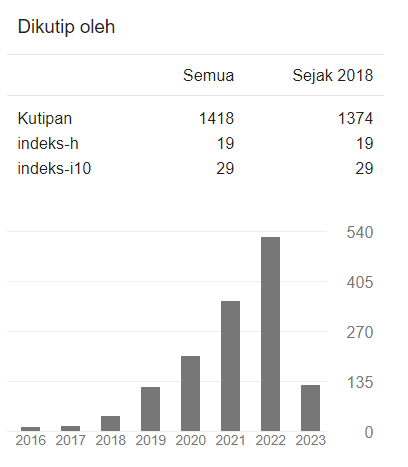Analisis Model Pembelajaran Daring Menggunakan Media PANDAWA
DOI:
https://doi.org/10.22219/jp2sd.v11i2.28752Keywords:
Media PANDAWA, minat belajar, model pembalajaran, pembalajaran daringAbstract
The COVID-19 pandemic has profoundly transformed the landscape of education. Initially, learning activities were face-to-face, then it switched to online activities. Various schools use application programs to assist learning activities between teachers and students. Bani Hasyim Islamic Elementary School developed a media called PANDAWA, which means online student guidelines (Panduan Daring Siswa). Teacher creativity in developing online learning media is interesting to be studied. The research objectives are (1) to describe model instructional using PANDAWA in school. (2) To describe the impact model instructional by using PANDAWA. The research employed descriptive qualitative conducted at SD Islam Bani Hasyim. Sources of data are the school principal, teachers, students and documents. Methods of data collection are namely interviews, observations, questionnaires, and document collection. PANDAWA media was developed by Bani Hasyim Islamic Elementary School teachers from the Google Form application and Microsoft Office PowerPoint. PANDAWA has features ranging from opening, classroom, materials, assignments and closing. Teaching materials are presented in the form of writing, infographics, and videos included in the features. PANDAWA is set with a password or code based on the classroom. Every morning, the teacher gives a code via WhatsApp to the class group to open PANDAWA. The impacts of PANDAWA on learning activities are (1) learning activities are carried out independently, (2) assignment-based activities to students, (3) PANDAWA does not yet have a virtual face-to-face feature; as a result, students only carry out virtual face-to-face meetings 2-3 times a week using the Google Meet, Zoom, and Whatsapp Groups applications, (4) evaluation of student learning cannot yet be detected objectively, (5) students experience boredom which affects student learning interest. PANDAWA makes it administratively more accessible for teachers to collect assignments.
Downloads
References
Adhe, K. R. (2018). Pengembangan Media Pembelajaran Daring Matakuliah Kajian PAUD di Jurusan PG PAUD Fakultas Ilmu Pendidikan Universitas Negeri Surabaya. Journal of Early Childhood Care and Education, 1(1), Article 1. https://doi.org/10.26555/jecce.v1i1.3
Alimuddin, A., & Nadjib, M. (2015). INTENSITAS PENGGUNAAN E-LEARNING DALAM MENUNJANG PEMBELAJARAN MAHASISWA PROGRAM SARJANA (S1) DI UNIVERISTAS HASANUDDIN. KAREBA : Jurnal Ilmu Komunikasi, 387–398. https://doi.org/10.31947/kjik.v4i4.635
Anugrahana, A. (2020). Hambatan, Solusi dan Harapan: Pembelajaran Daring Selama Masa Pandemi Covid-19 Oleh Guru Sekolah Dasar. Scholaria: Jurnal Pendidikan Dan Kebudayaan, 10(3), 282–289. https://doi.org/10.24246/j.js.2020.v10.i3.p282-289
Asmuni, A. (2020). Problematika Pembelajaran Daring di Masa Pandemi Covid-19 dan Solusi Pemecahannya. Jurnal Paedagogy, 7, 281. https://doi.org/10.33394/jp.v7i4.2941
Astutik, W. (2015). Slameto, Belajar Dan Faktor-Faktor Yang Mempengaruhinya.(Jakarta: Rineka Cipta. 1995) Hal 20 8 Digilib. Uinsby. Ac. Id Digilib. Uinsby. Ac. Id Digilib. Uinsby. Ac. Id Digilib. Uinsby. Ac. Id Digilib. Uinsby. Ac. Id Digilib. Uinsby. Ac. Id Digilib. Uinsby. Ac. Id. Skripsi, 8–44.
Cahyani, A., Listiana, I. D., & Larasati, S. P. D. (2020). Motivasi Belajar Siswa SMA pada Pembelajaran Daring di Masa Pandemi Covid-19. IQ (Ilmu Al-Qur’an): Jurnal Pendidikan Islam, 3(01), Article 01. https://doi.org/10.37542/iq.v3i01.57
Cahyati, N., & Kusumah, R. (2020). Peran Orang Tua Dalam Menerapkan Pembelajaran Di Rumah Saat Pandemi Covid 19. Jurnal Golden Age, 4(01), 152–159. https://doi.org/10.29408/goldenage.v4i01.2203
Dewi, W. A. F. (2020). Dampak COVID-19 terhadap Implementasi Pembelajaran Daring di Sekolah Dasar. EDUKATIF : JURNAL ILMU PENDIDIKAN, 2(1), 55–61. https://doi.org/10.31004/edukatif.v2i1.89
Fauziyah, N. (2020). Dampak Covid-19 Terhadap Efektivitas Pembelajaran Daring Pendidikan Islam. Al-Mau’izhoh, 2(2). https://doi.org/10.31949/am.v2i2.2294
Firman, F., & Rahayu, S. (2020). Pembelajaran Online di Tengah Pandemi Covid-19. Indonesian Journal of Educational Science (IJES), 2(2), 81–89. https://doi.org/10.31605/ijes.v2i2.659
Habibah, R., Salsabila, U. H., Lestari, W. M., Andaresta, O., & Yulianingsih, D. (2020). Pemanfaatan Teknologi Media Pembelajaran di Masa Pandemi Covid-19. Trapsila: Jurnal Pendidikan Dasar, 2(02), 1–13. https://doi.org/10.30742/tpd.v2i2.1070
Hadisi, L., & Muna, W. (2015). PENGELOLAAN TEKNOLOGI INFORMASI DALAM MENCIPTAKAN MODEL INOVASI PEMBELAJARAN ( E-LEARNING ). Al-TA’DIB: Jurnal Kajian Ilmu Kependidikan, 8(1), 117–140. https://doi.org/10.31332/atdb.v8i1.396
Jusmawati, J., Satriawati, S., & Sabillah, B. M. (2020). PENGARUH PEMBELAJARAN BERBASIS DARING TERHADAP MINAT BELAJAR MAHASISWA PGSD UNIMERZ PADA MATA KULIAH PENDIDIKAN MATEMATIKA. JKPD (Jurnal Kajian Pendidikan Dasar), 5(2), 106–111. https://doi.org/10.26618/jkpd.v5i2.3934
Ludigdo, U. (2006). Kerangka metodologi dalam memahami praktik etika di kantor akuntan publik. Proceeding: The 2nd Postgraduate Consortion on Accounting. Brawijaya University. Malang.
Munir, D., & It, M. (2009). Pembelajaran jarak jauh berbasis teknologi informasi dan komunikasi. Bandung: Alfabeta, 24, 44–47.
Prawanti, L. T., & Sumarni, W. (2020). Kendala Pembelajaran Daring Selama Pandemic Covid-19. Prosiding Seminar Nasional Pascasarjana, 3(1), 286–291. https://proceeding.unnes.ac.id/index.php/snpasca/article/view/603
Prayogi, R., Suryatna, U., & Kusumadinata, A. A. (2015). HUBUNGAN KOMUNIKASI PEMBELAJARAN SISTEM E-LEARNING DENGAN MOTIVASI BELAJAR SISWA (KASUS PADA SMK WIKRAMA KOTA BOGOR). JURNAL KOMUNIKATIO, 1(2). https://doi.org/10.30997/jk.v1i2.174
Rachmat, A., & Krisnadi, I. (2020). Analisis efektifitas pembelajaran daring (online) untuk siswa SMK Negeri 8 Kota Tangerang pada saat pandemi covid 19. Jurnal Pendidikan, 1(1), 1–7. https://www.academia.edu/download/64275703/Analisis_Efektifitas_Pembelajaran_Daring.pdf
Sari, P. (2015). MEMOTIVASI BELAJAR DENGAN MENGGUNAKAN E-LEARNING. Ummul Qura, 6(2), 20–35. http://ejournal.kopertais4.or.id/pantura/index.php/qura/article/view/2048
Sobron, A. N., & Bayu, R. (2019). Persepsi siswa dalam studi pengaruh daring learning terhadap minat belajar ipa. SCAFFOLDING: Jurnal Pendidikan Islam Dan Multikulturalisme, 1(2), 30–38. https://ejournal.insuriponorogo.ac.id/index.php/scaffolding/article/view/117
Syarifudin, A. S. (2020). IMPELEMENTASI PEMBELAJARAN DARING UNTUK MENINGKATKAN MUTU PENDIDIKAN SEBAGAI DAMPAK DITERAPKANNYA SOCIAL DISTANCING. Jurnal Pendidikan Bahasa dan Sastra Indonesia Metalingua, 5(1), 31–34. https://doi.org/10.21107/metalingua.v5i1.7072
Wicaksana, E. J., Atmadja, P., & Muthia, G. A. (2020). E-LEARNING EDMODO DENGAN MODEL PBL UNTUK MENINGKATKAN MINAT BELAJAR SISWA PADA MASA PANDEMI COVID-19. Jurnal Pendidikan Biologi, 12(1), 22–29. https://doi.org/10.17977/um052v12i1p22-29
Yanti, M. T., Kuntarto, E., & Kurniawan, A. R. (2020). PEMANFAATAN PORTAL RUMAH BELAJAR KEMENDIKBUD SEBAGAI MODEL PEMBELAJARAN DARING DI SEKOLAH DASAR. Adi Widya: Jurnal Pendidikan Dasar, 5(1), 61–68. https://doi.org/10.25078/aw.v5i1.1306
Yunitasari, R., & Hanifah, U. (2020). Pengaruh Pembelajaran Daring terhadap Minat Belajar Siswa pada Masa COVID 19. EDUKATIF : JURNAL ILMU PENDIDIKAN, 2(3), 232–243. https://doi.org/10.31004/edukatif.v2i3.142
Downloads
Published
Issue
Section
License
Copyright (c) 2023 Jevita Wijaya, Herawati Susilo, Parno Parno

This work is licensed under a Creative Commons Attribution-ShareAlike 4.0 International License.
Authors who publish with Jurnal Pemikiran dan Pengembangan Sekolah Dasar (JP2SD) agree to the following terms:
- For all articles published in Jurnal Pemikiran dan Pengembangan Sekolah Dasar (JP2SD), copyright is retained by the authors. Authors give permission to the publisher to announce the work with conditions. When the manuscript is accepted for publication, the authors agree to automatic transfer of the publishing right to the publisher.
- Authors retain copyright and grant the journal right of first publication with the work simultaneously licensed under a Creative Commons Attribution-ShareAlike 4.0 International License that allows others to share the work with an acknowledgment of the work's authorship and initial publication in this journal.
- Authors are able to enter into separate, additional contractual arrangements for the non-exclusive distribution of the journal's published version of the work (e.g., post it to an institutional repository or publish it in a book), with an acknowledgment of its initial publication in this journal.
- Authors are permitted and encouraged to post their work online (e.g., in institutional repositories or on their website) prior to and during the submission process, as it can lead to productive exchanges, as well as earlier and greater citation of published work (See The Effect of Open Access).

This work is licensed under a Creative Commons Attribution-ShareAlike 4.0 International License.


















